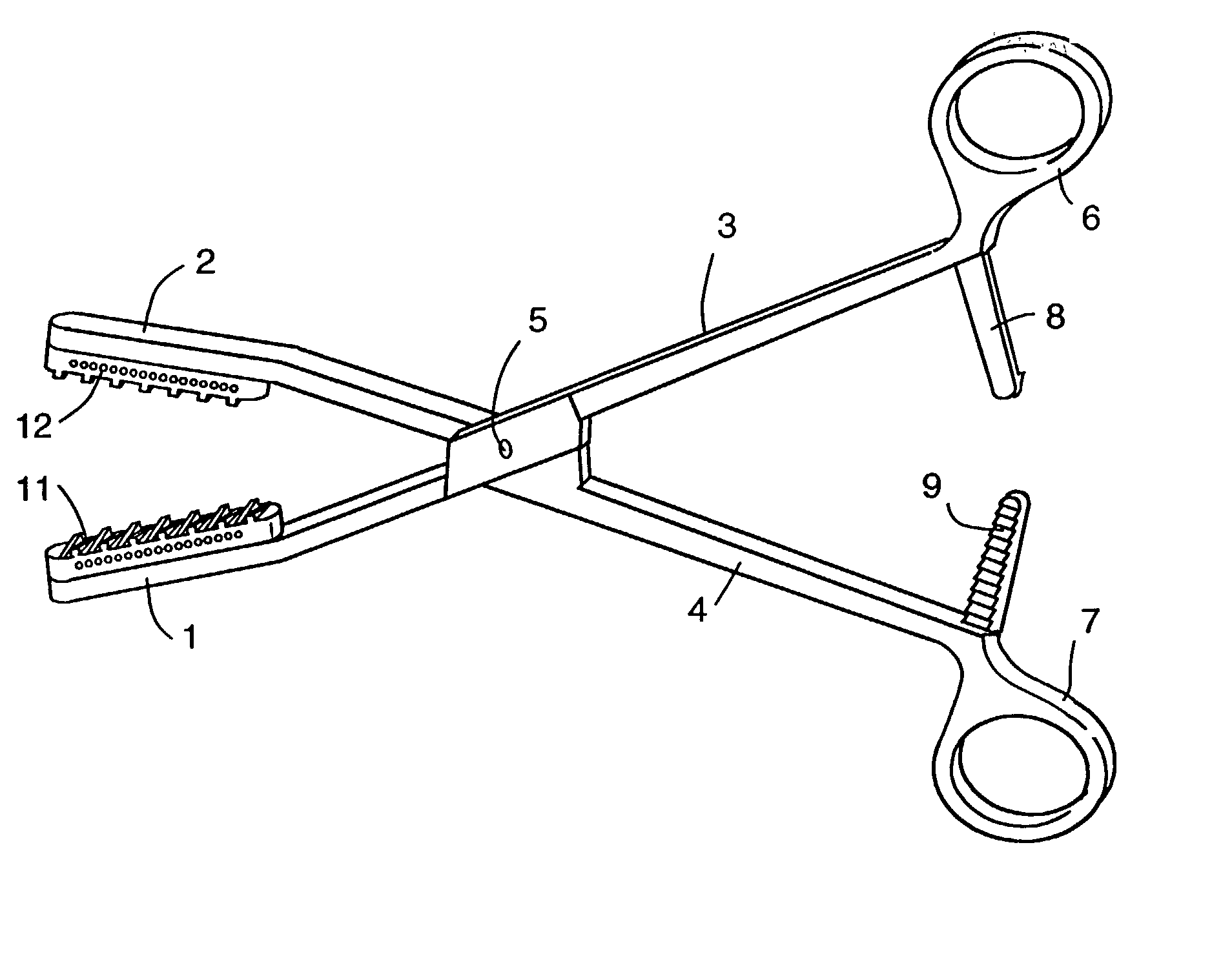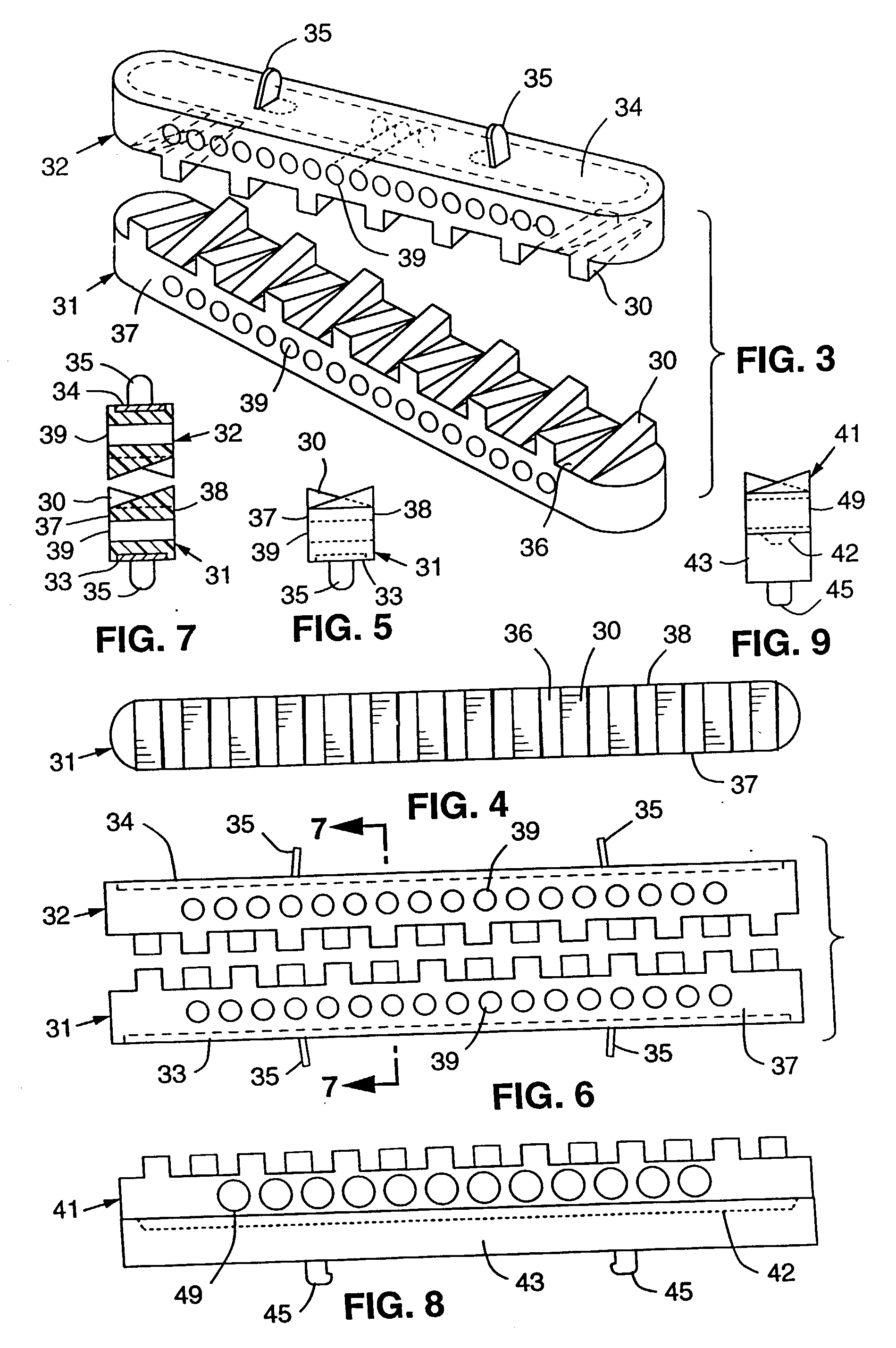Surgical clamp pad with interdigitatin teeth
a clamping device and interdigital technology, applied in the field of surgical clamping devices, can solve the problems of devices likewise prone to slipping off of the clamping vessel, easy slippage, and trauma to the clamping vessel at the clamping si
- Summary
- Abstract
- Description
- Claims
- Application Information
AI Technical Summary
Benefits of technology
Problems solved by technology
Method used
Image
Examples
first embodiment
[0043] a clamping member according to the present invention is depicted in FIGS. 3-9. Resilient pads 31 and 32 are attached to base members 33 and 34, respectively. Pads 31 and 32 are comprised of silicone and formed around base members 33 and 34 by a conventional liquid injection-molding process well known in the art. Once the pads cure or harden, the base members are permanently secured to the pads. Base members 33 and 34 are formed of stainless steel and include spaced apart tabs 35, 35 that can be detachably secured within corresponding recesses in the jaw of a surgical clamp. The tabs are slightly angled toward each other and the respective recesses are undercut so that once the tabs are placed within the recesses, the ends of the tabs snap beneath the undercut, releasably securing the pad to the jaw.
[0044] Protrusions in the general shape of wedges 30 extend from planar surface 36 of each pad 31, 32. The wedges are arranged in rows along the length of each pad and each wedge i...
second embodiment
[0051] A second embodiment of a clamping member according to the present invention is depicted in FIGS. 10-14. Resilient pads 61 and 62 are attached to base members 63 and 64, respectively. Preferably, the pads 61 and 62 are of 50 durometer silicone (GE 6050) and are formed around base members 63 and 64 in similar fashion as described above for the first embodiment. Again, base members 63 and 64 are formed of stainless steel, and include tabs 65, 65 that can be detachably coupled to corresponding recesses in the jaw of a surgical clamp. Cylindrical protrusions 60 extend from planar surface 66 of each pad 61, 62. The protrusions 60 are arranged in two rows along the length of each pad 61, 62 with the protrusions of the first row staggered relative to the protrusions of the second row, as depicted in FIG. 11. As shown in FIG. 12, the cylindrical protrusions 60 extend from the pad surface 66 perpendicular to the pad surface and can terminate in hemi-spherical tips. The protrusions have...
third embodiment
[0054] A third embodiment of a clamping member according to the present invention is depicted in FIGS. 15-19. Resilient pads 71 and 72 are formed of 40 durometer silicone (GE 6040) and attached to base members 73 and 74, respectively, preferably by the use of an adhesive. The base members 73 and 74 are formed of a hard plastic, such as polycarbonate, and include knobs 75, 75 that can be detachably coupled to corresponding recesses in the jaw of a surgical clamp, as described above with respect to the FIG. 8 and 9 variation of the first embodiment. Cylindrical protrusions 70 extend from planar surface 76 of each pad 71 and 72, and are arranged in a single row along the length of each pad, as depicted in FIGS. 15-18. As shown in FIG. 17, the cylindrical protrusions 70 extend from the pad surface 76 in a direction perpendicular to the pad surface. The cylindrical protrusions 70 themselves terminate in conical tips 77. In alternative embodiments, the protrusions can terminate in rounded...
PUM
 Login to View More
Login to View More Abstract
Description
Claims
Application Information
 Login to View More
Login to View More - R&D
- Intellectual Property
- Life Sciences
- Materials
- Tech Scout
- Unparalleled Data Quality
- Higher Quality Content
- 60% Fewer Hallucinations
Browse by: Latest US Patents, China's latest patents, Technical Efficacy Thesaurus, Application Domain, Technology Topic, Popular Technical Reports.
© 2025 PatSnap. All rights reserved.Legal|Privacy policy|Modern Slavery Act Transparency Statement|Sitemap|About US| Contact US: help@patsnap.com



